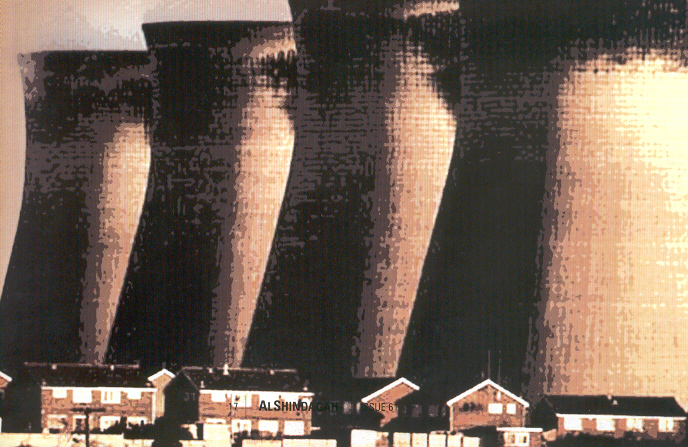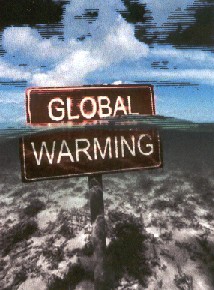|
On
September 30, in a surprising and very welcome move,
Russia finally agreed to ratify the Kyoto Protocol on
global warming, agreed upon by more than 150 nations in
December 1997. Under its terms, signatories are
committed to reducing emissions of green house gases by
an average of eight per cent by 2010. Russia accounts
for 17 per cent of world emissions.
Carbon dioxide levels are currently
the highest in more than 420,000 years, prompting the
Intergovernmental Panel on Climate Change (IPCC) to warn
that unless carbon dioxide levels are severely reduced
the Earth average temperature will rise by as much as
5.8 degrees centigrade by 2100. Such a reduction demands
the slashing of human-generated greenhouse gas emissions
by as much as 80 per cent by 2050 at the very latest.
Greenhouse gases are so called
because they act like glass in a greenhouse, trapping
heat. The burning of coal, oil and natural gas increases
concentrations of these gases in the atmosphere. Major
sources of such gases are power plants, gas guzzling
automobiles as well as the cutting down and burning of
timber. Deforestation contributes to the problem.
Shockingly, the world’s worst emitter
of all carbon dioxide from fossil fuels, the U.S, has
shied away from signing up to Kyoto. Although the U.S.
boasts a mere 4.5 per cent of the world’s population, it
is responsible for a quarter of all greenhouse gas
emissions worldwide.
America’s ally Australia – another
heavy polluter – has shamefully gone down the same “I’m
all right Jack” route. Only 0.3 per cent of the world’s
population live in Australia but they emit the highest
per capita levels of greenhouse gas pollution in the
world.
In spite of heavy global pressure,
President George W. Bush consistently refused to
contemplate signing up to Kyoto – even though his
predecessor Clinton had agreed in principle to cut
emissions by seven per cent - putting the already
bulging pockets of his corporate friends before the well
being of the planet.
Those friends include members of a
powerful coalition of oil, power and auto companies,
which deny the harm they cause, and have spent millions
of dollars attempting to discredit the scientific
evidence which backs up the global warming concept.
Among them are Amoco, Chevron,
Chrysler, Exxon, Ford, General Motors, Goodyear, Mobil,
Texaco, Union Carbide, American Electric Power and
Western Fuels. Although their counter claims fall on
deaf ears as far as the American public goes, they carry
weight with the White House and Congress. Many are
Bush-Cheney campaign contributors.
In early 2001, George W. Bush formed
an energy task force headed by Vice-President Dick
Cheney to develop a national energy policy. Its findings
were kept secret until a judge ordered some of them
released in to the public domain in 2002.
Although heavily censored, they
revealed Bush administration officials sought extensive
advice from utility companies as well as the oil, gas,
coal and nuclear energy industries, and incorporated
their recommendations – often word for word – into their
energy plan. There was little, if any, thought given to
global warming.
Global warming, resulting from human
activities that release heat-trapping gases and
particles into the air, can and should be tackled by all
of the world’s leaders. The future of mankind rests in
their hands, which makes the isolationist attitudes of
the U.S. and Australia all the more incomprehensible and
unacceptable.
Judging by statistical records, the
situation may be already dire. The U.N. World
Meteorological Organisation states that last year was
the third warmest since records were first kept in the
1860s. The previous year 2002 was the second hottest,
while 1998 broke the record.
Over the past 100 years Earth’s
temperatures have risen by an average of six degrees
centigrade, while ten out of 18 of the warmest years on
record have occurred during the past 14 years.
What have we done?
Studies have
shown that plants and animals are changing their habits
and behaviour in response to climate shifts. Angela Eiss,
science historian and author of “What have we done?”
told the New Scientist that Arctic wildlife such
as polar bears have already suffered from global
warming.
“Polar bears,” she says, “used to
rely on sea ice to reach their prey. When it melted,
they started dying in droves…” She warns that the
caribou is going the same way and is likely to be
extinct by 2110.
Changes
in our environment have already occurred with receding
mountain glaciers the norm. Since 1900, there has been a
50 per cent reduction in glacier ice in the European
Alps, while the Arctic ice pack has already lost about
40 per cent of its thickness during the past 40 years.
These trends are partly responsible
for the rising global sea level, which has risen three
times faster in the past 100 years than it did during
the previous three millennia.
The environmental group WWF has said
billions of people will face severe water shortages as
glaciers around the world melt. Ecuador, Peru and
Bolivia would be worst affected, it predicted, while in
the Himalayas, there was a grave danger of flooding.
Scientists warn if our Earth
continues to heat up, we could face catastrophic
consequences. Among the most severe will be rising sea
levels, severe floods, devastating cyclones, hurricanes,
heat waves and droughts, resulting in diminishing
potable water resources, the destruction of lives and
property, and the spread of infectious diseases, carried
by insects and rodents. The world’s poorest will, as
usual, bear the brunt of these catastrophes.
Although, Eiss warns that some parts
of the world must prepare for a greater prevalence of
el-niños, northern Europeans are “enjoying a much better
climate than their grandparents did”. This comes with
the caveat that “they shouldn’t feel too smug” as “there
could be a strange reversal on the way.”
She explains this reversal by saying:
“Because the ocean’s getting so much warmer than it used
to be, and also because there is more fresh water
running into the Northern Atlantic, it looks as if the
seawater’s becoming much less dense. The sinking might
stop any day now. If that happens, all the warming could
start to reverse in Britain and northern Europe, and
they might even plunge into a mini ice age...”
Ross Gelbspan, author of “The Heat is
on: the Climate Crisis, the Cover-up, the Prescription”
believes there will be a permanent state of emergency
due to climate change. He writes: “Long before the
systems of the planet buckle, democracy will
disintegrate under the stress of ecological disasters
and their social consequences.
So what can be done to diminish this
frightening trend?
The
U.S. Public Interest Research Group suggests increasing
fuel efficiency standards to 45 miles per gallon for
cars and 34 miles per gallon for light trucks; putting a
cap on carbon dioxide from power plants, as well as
decreasing pollution that causes acid rain, smog and
respiratory illness; and shifting investment from fossil
fuels to renewable energy and energy efficiency. The
group also recommends that the U.S. ratify the Kyoto
Protocol.
What’s on tap?
The National
Resources Defence Council (NRDC) blames the Bush
administration for “making the problem worse instead of
better. Seemingly more concerned about protecting
corporate polluters than protecting public health, the
administration is campaigning to hobble existing laws,
thwart efforts to strengthen current pollution standards
and cut funds for programmes that protect tap water.”

In its carefully researched study of
the drinking water in 19 U.S. cities “What’s on Tap?”
NRDC says drinking water is polluted and poses health
risks to some residents. Lead, pathogens (germs) and
carcinogenic by-products of chlorine treatment, which
sometimes cause reproductive problems, as well as
arsenic, radon and rocket fuel were found in the water.
It asks Congress to act to strengthen the laws and
contaminant standards to protect the purity and safety
of U.S. drinking water and demands that the
administration’s broad assault on Clean Water Act
protections should be stopped.
The Environmental Protection Agency (EPA)
reports that one third of America’s lakes and
one-quarter of its rivers are contaminated with mercury
and other pollutants, which could cause health problems
for children and pregnant women who eat fish. Although
adults rarely suffer health problems from eating fish
laden with mercury, the nervous systems of children and
babies in the womb can be severely damaged.
Lake Champlain, Lake Michigan, San
Francisco Bay and Columbia River in the Pacific
Northwest are among waterways contaminated with mercury,
generally thought to have originated from incinerators
and power plants that burn coal.
One of the best-known champions of
clean water is Erin Brockovich. After a serious car
accident, the unemployed mother of three with no formal
education begged a California law firm to take her on as
a filing clerk. While browsing through medical records,
she discovered a community plagued by severe health
problems related to the local water supply.
After she persuaded her reluctant
boss to pursue the case, she won the community’s
confidence and gathered together over 600 plaintiffs.
The result was the Pacific Gas and Electric Company –
responsible for the leakage of Chromium 6, which had
seeped into the ground water from its nearby compressor
station – was forced to hand over US$333 million.
Brockovich’s amazing story was later made into an
Oscar-nominated movie starring Julia Roberts.
Dirty Air

The EPA
estimated that more than 120 million Americans live in
areas where the air is unhealthy. This aggravates
respiratory problems, such as asthma and emphysema to
premature death. Air pollution also harms the
environment, causes acid rain, ozone damage to trees and
crops, mercury contamination and contributes to global
warming. Electric power plants, it says, are the “single
largest industrial source of some of the worst air
pollutants...”
Last year, the Bush administration
came up with a clean air initiative called “Clear
Skies”. However, NRDC says “Clear Skies” is a misnomer
because it weakens health protections already required
under the Clean Air Act. New targets have been set for
emissions for sulphur dioxide, mercury and nitrogen
oxides from U.S. power plants but these targets are
weaker than those in place under current laws.
Furthermore, “Clear Skies” makes no mention of capping
carbon dioxide emissions or the related threat to global
warming.
Most Polluted
City
While there is
no doubt the Bush administration is one of the most
environmentally unfriendly the U.S. has had in recent
times, American cities have a long way to go to catch up
with the rates of pollution in the world’s most polluted
town. In Mexico City, children rarely use blue when they
paint the sky. Mexico City has been named “the most
dangerous city in the world for children in terms of air
pollution” by the U.S.-based World Resources Institute.
Beijing, Shanghai, Tehran and Calcutta aren’t far
behind.
Isn’t it time for our leaders to
spend less time chasing shadows and more concentrating
on preserving the planet not only for ourselves but also
for future generations.
Are we really prepared to leave behind a legacy of poor
air, contaminated water and a hole in the ozone layer
too big to repair so that mega international
corporations can hand political parties along with their
executives and shareholders just a few dollars more? | 